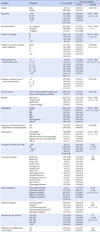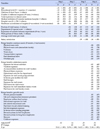Abstract
Purpose
The purpose of this study was to explore the predictors of turnover intention among nurses working in small and medium-sized hospitals in South Korea.
Methods
Data were obtained from a survey conducted in 2016 on welfare policy and system improvement. The participants were nurses of the Korean Nurses Association who worked in small and medium-sized hospitals. The responses of 2,011 nurses were analyzed using hierarchical multiple regression analysis, which was performed to explore the predictors of nurses' turnover intentions.
Results
The findings of this study showed that the predictors significantly reducing nurses' desire to leave their hospitals were a 40-hour workweek, satisfaction with the salary, and six out of the 40 fringe benefits provided by their hospitals: the provision of uniforms and work shoes, paid menstrual leave, operational costs for the department, job-related educational costs, and in-house nurse training program.
Figures and Tables
References
1. Paek SJ. Applying to 'small and medium hospital standards' under 300 beds. Dailymed. 2011. 10. 25. Sect. 01. Available from: http://www.dailymedi.com/detail.php?number=731808.
2. Duffield CM, Roche MA, Homer C, Buchan J, Dimitrelis S. A comparative review of nurse turnover rates and costs across countries. J Adv Nurs. 2014; 70(12):2703–2712. DOI: 10.1111/jan.12483.
3. Korean Hospital Nurses Association. Survey on working condition of nursing workforce in hospitals (2016). Seoul: Korean Hospital Nurses Association;2016.
4. Takase M, Teraoka S, Yabase K. Retaining the nursing workforce: Factors contributing to the reduction of nurses' turnover intention in Japan. J Nurs Manag. 2016; 24(1):21–29. DOI: 10.1111/jonm.12266.
5. Chang YJ. A study on small & medium hospital industry activation [dissertation]. Changwon: Kyungnam University;2009.
6. Park SK, Cho KM, Jwa YK, Yi YJ. Nurses' activities survey. Osong: Korea Health Industry Development Institute;2014.
7. Kang KN. Factors influencing turnover intention of nurses in small-medium sized hospitals. J Korean Acad Nurs Adm. 2012; 18(2):155–165. DOI: 10.11111/jkana.2012.18.2.155.
8. Kwon JO, Kim EY. Impact of unit-level nurse practice environment on nurse turnover intention in the small and medium sized hospitals. J Korean Acad Nurs Adm. 2012; 18(4):414–423. DOI: 10.11111/jkana.2012.18.4.414.
9. Yoo SJ, Choi YH. Predictive factors influencing turnover intention of nurses in small and medium-sized hospitals in Daegu city. J Korean Acad Nurs Adm. 2009; 15(1):16–25.
10. Yang H, Lv J, Zhou X, Liu H, Mi B. Validation of work pressure and associated factors influencing hospital nurse turnover: A cross-sectional investigation in Shaanxi Province, China. BMC Health Serv Res. 2017; 17(1):112. DOI: 10.1186/s12913-017-2056-z.
11. Simon M, Müller BH, Hasselhorn HM. Leaving the organization or the profession-a multilevel analysis of nurses' intentions. J Adv Nurs. 2010; 66(3):616–626. DOI: 10.1111/j.1365-2648.2009.05204.x.
12. Han K, Trinkoff AM, Gurses AP. Work-related factors, job satisfaction and intent to leave the current job among United States nurses. J Clin Nurs. 2015; 24(21-22):3224–3232. DOI: 10.1111/jocn.12987.
13. Park KO. Supply and demand of nursing manpower for small and medium hospitals in rural area: Nursing shortage versus wage disparity. Perspect Nurs Sci. 2009; 6(1):67–76.
14. Oh EH, Chung BY. The effect of empowerment on nursing performance, job satisfaction, organizational commitment, and turnover intention in hospital nurses. J Korean Acad Nurs Adm. 2011; 17(4):391–401. DOI: 10.11111/jkana.2011.17.4.391.
15. Miceli MP, Lane MC. Antecedents of pay satisfaction: A review and extension. In : Rowland KM, Ferris GR, editors. Research in personnel and human resources management: A research annual. Volume 9. Greenwich, Conn.: JAI Press;1991. p. 235–309.
16. Lee WU. Human resource management. 2nd ed. Seoul: Samyoungsa;2005. p. 272–283.
17. Lee ES, Chang JY, Chun MH. The relationship between the satisfaction of benefits, job satisfaction and turnover intention of nurses in small-medium sized hospitals. Korean Nurse. 2004; 43(4):66–81.
18. Lee HS, Kim JW, Kim SH, Hwang SK. The effect of worker's job satisfaction and turnover intention of hospital welfare. Korean J Health Serv Manag. 2012; 6(3):107–115.
19. Hwang HY, Park JH. The survey of welfare demand on nurses in the small and medium sized hospitals. Seoul: Korea Nurses Association;2017. p. 7–12.
20. Lawler EE. Satisfaction and behavior. In : Hackman JR, Lawler EE, Porter LW, editors. Perspectives on behavior in organizations. 2nd ed. New York: McGraw-Hill;1983. p. 78–97.
21. Mobley WH. Employee turnover: Causes, consequences, and control. Reading, Mass: Addison-Wesley;1982.
22. Kim MR. Influential factors on turnover intention of nurses: The affect of nurse's organizational commitment and career commitment to turnover intention. J Korean Acad Nurs Adm. 2007; 13(3):335–344.
23. National Institute of Korean Language. Wage [Internet]. cited April 15, 2017. Available from: http://stdweb2.korean.go.kr/search/View.jsp?idx=276568.
24. Song JH, Jang YH. Employee benefits of non-regular workers. J Welf Adm. 2014; 30:3–24.
25. Kim S, Lee KE. Predictors of turnover among new nurses using multilevel survival analysis. J Korean Acad Nurs. 2016; 46(5):733–743. DOI: 10.4040/jkan.2016.46.5.733.
26. Ministry of Employment and Labor (KR). The 2014 report of enterprise labor cost survey [Internet]. Seoul: Ministry of Employment and Labor;2014. cited April 15, 2017. Available from: http://www.moel.go.kr/view.jsp?cate=3&sec=17&mode=view&pimSeq=1&piSeq=1&bbs_cd=OP0211&state=A&seq=1441007348696.
27. Jeong JH, Kim JS, Kim KH. The risk factors influencing turnover intention of nurses. J Korean Acad Nurs Adm. 2008; 14(1):35–44.
28. Kim MA, Park KO, You SJ, Kim MJ, Kim ES. A survey of nursing activities in small and medium-size hospitals: Reasons for turnover. J Korean Clin Nurs Res. 2009; 15(1):149–165.
29. Chawla D, Sondhi N. Assessing the role of organizational and personal factors in predicting turn-over intentions: A case of school teachers and BPO employees. Decision. 2011; 38(2):5–33.




 PDF
PDF ePub
ePub Citation
Citation Print
Print






 XML Download
XML Download